Understanding landing page optimization best practices is crucial for your lead generation strategy.
Optimizing a landing page only after its conversion rate declines poses two major challenges: an overwhelming volume of unsorted data and insufficient time to A/B test every hypothesis. With pressure mounting from leadership, the temptation to make gut-based decisions can lead to costly mistakes.
Landing page optimization works by aligning your pages with potential customers’ demands. Robust user-behavior tracking tools and the right marketing strategy help optimize landing pages for lesser bounce rates and more conversions.
This article will share our top landing page optimization best practices with helpful examples and case studies. It will help your target audience achieve precisely what you want—quick conversions.

Landing page optimization (LPO) is the process of improving key elements of a landing page—from design to page speed. Using data-driven insights, LPO aims to enhance user experience and maximize conversions.

As a business owner, you must understand that landing pages are critical for your sales funnel. When designed using landing page optimization best practices, landing pages can help secure high-potential leads.

How does one optimize a landing page for lead generation? Contrary to popular opinion, it doesn’t have to be complicated and requires some effort to ensure the page you’ve created completes the goals you want. To achieve that most efficiently, we bring you our landing page optimization best practices to boost performance.
Before you improve your landing page, you need to know which numbers matter most to you. These are your key performance indicators (KPIs).
Setting up these KPIs at the start is critical, as landing pages differ depending on their targeted funnel stage or may be customized for specific campaigns aligned with your brand’s aims. Simply tracking the conversion rate often doesn’t provide enough insight to guide effective optimizations—you need a broader set of metrics to understand your landing page performance fully.
Essential landing page KPIs include average engagement time, bounce rate, conversion rate, and form abandonment rate.
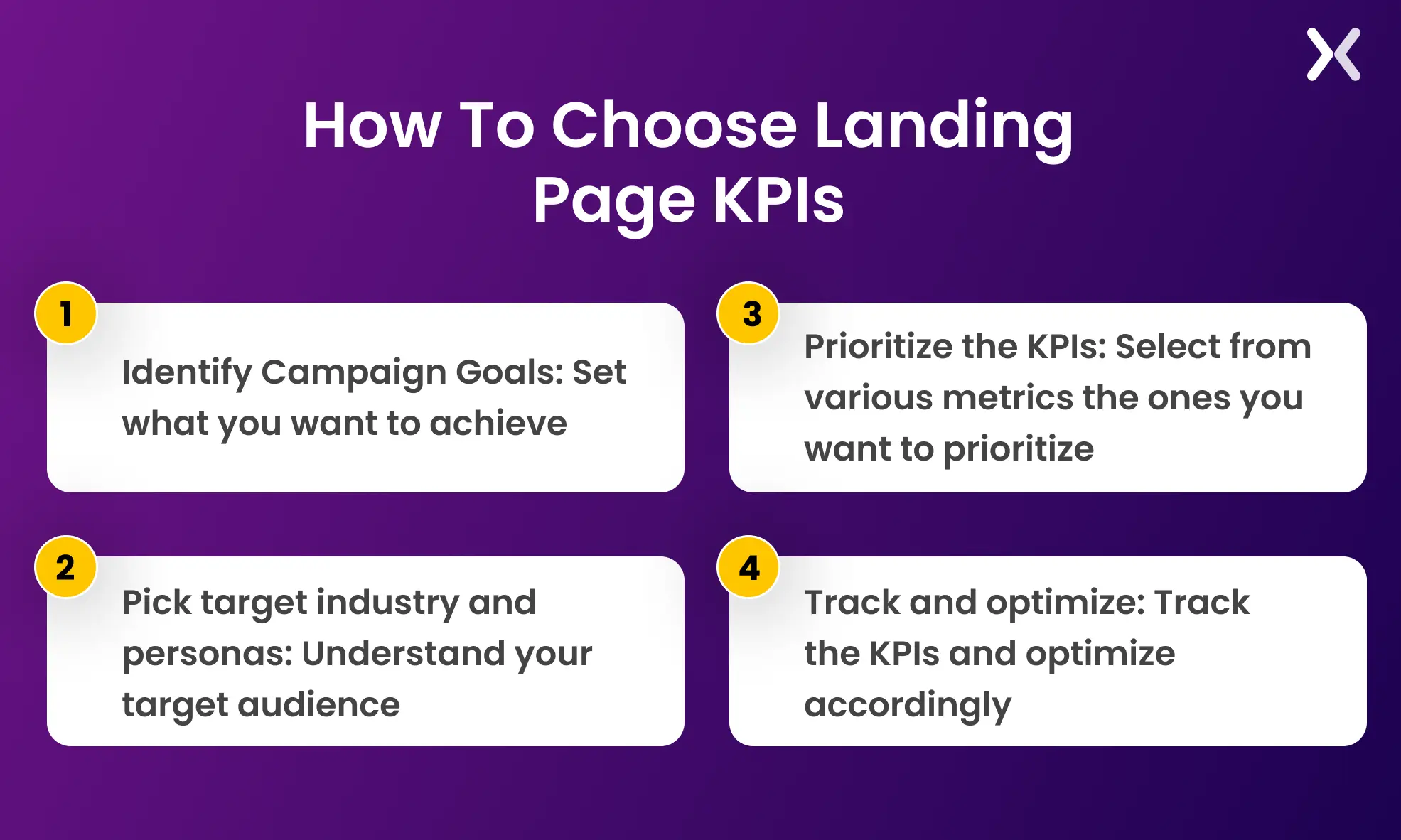
As part of landing page optimization best practices, such metrics can be easily tracked with Google Analytics 4 (GA4). GA4 offers comprehensive insights and customizable reports to help you monitor and optimize these critical KPIs.
After your landing page goes live, start by creating a regular schedule to review and analyze performance metrics and KPIs in line with landing page optimization best practices.
When Page Receives High Traffic If the page receives high traffic volume, consider checking the metrics daily. It will help you spot trends, catch possible problems, and take advantage of any opportunities to improve.
When Page Receives Low Traffic For pages with fewer visitors, a weekly review can work well. It lets you spot patterns, see how visitors engage with your page, and make slow, data-based tweaks. Such steady tracking helps you keep improving, boosting conversion rates and ensuring the page matches your goals.

“Review landing pages every two weeks—or weekly for high-traffic sites. Benchmark against industry standards, like Unbounce's annual report, and adjust based on A/B test results.”
Metrics tell part of the story when it comes to landing page optimization. To boost your page’s effectiveness, you need to use different UX tools like heatmaps, A/B testing, and competitor analyses. These tools play a significant role in landing page optimization best practices.
Building a solid tech set for optimizing landing pages is crucial for a thorough approach to CRO. It ensures you always have the right tools to improve every landing page element. Tools such as Unbounce, VWO, Crazy Egg, Hexometer, etc., offer robust testing and UX analysis features. They help you monitor user behavior, A/B test webpages, and keep your landing page growing effortlessly.

These tools help you create a reliable optimization stack that simplifies setup and ongoing improvements, letting you build high-performing landing pages.
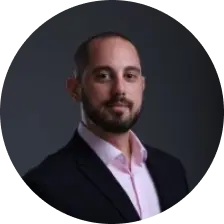
“In order to create a good looking, fast landing page with a high quality score requires significant technical knowledge and often help from developers and/or designers.”
Understanding the ins and outs of your data is one of the essential landing page optimization best practices. There are two main types of marketing data: quantitative and qualitative. Both are essential for effective optimization, and a deeper dive into each can help you build more robust fact-based testing hypotheses.
Quantitative data involves metrics like page views, bounce rates, and conversion rates. Measurable data from tools like Google Analytics 4 (GA4) helps you monitor your page’s performance and identify seasonal patterns.
Qualitative data, on the other hand, examines the reasons behind users’ behavior. Heatmaps, session recordings, and user feedback collect this information, show how users engage with different parts of your landing page, and pinpoint problem areas or areas of distraction.
Together, both types of data give you a complete picture of the user’s behavior. It allows you to make specific improvements that enhance the user experience and increase conversion.
Building a clear hypothesis is essential for focused A/B testing. As part of landing page optimization best practices, a precise, testable hypothesis can enhance actionable insights. Without a strong hypothesis, you risk unfocused tests and inconclusive findings.
Data-backed hypotheses are especially powerful. They align tests with real user behavior and pinpoint critical areas for improvement. A testable hypothesis has three central elements: action, outcome, and reasoning.

By grounding hypotheses in data rather than guesswork, you improve the accuracy of results and make optimizations that genuinely impact performance. This approach keeps testing efficient, targeted, and aligned with business goals.
When marketers collect all their data and ideas, directly going to testing can become too much. With many possible landing page tests and little time, the tricky part is figuring out where to start—when each hypothesis promises valuable insights or gains. At these times, it’s crucial to prioritize and focus on the most impactful hypothesis first.
At Apexure, we tackle this problem with our EPIC CRO framework. It is a homemade method that helps us rank ideas based on their impact, ease, and cost-effectiveness. For us, it is one of the most landing page optimization best practices.
The EPIC framework helps us evaluate each possible hypothesis to consider its potential influence on conversions, resources needed, and completion time. It also lets us determine which actions yield the best results. This organized method allows us to fine-tune our CRO work, ensuring we test the most powerful, urgent, and budget-friendly ideas first. Ultimately, it boosts traffic while keeping things simple and easing the strain on resources.
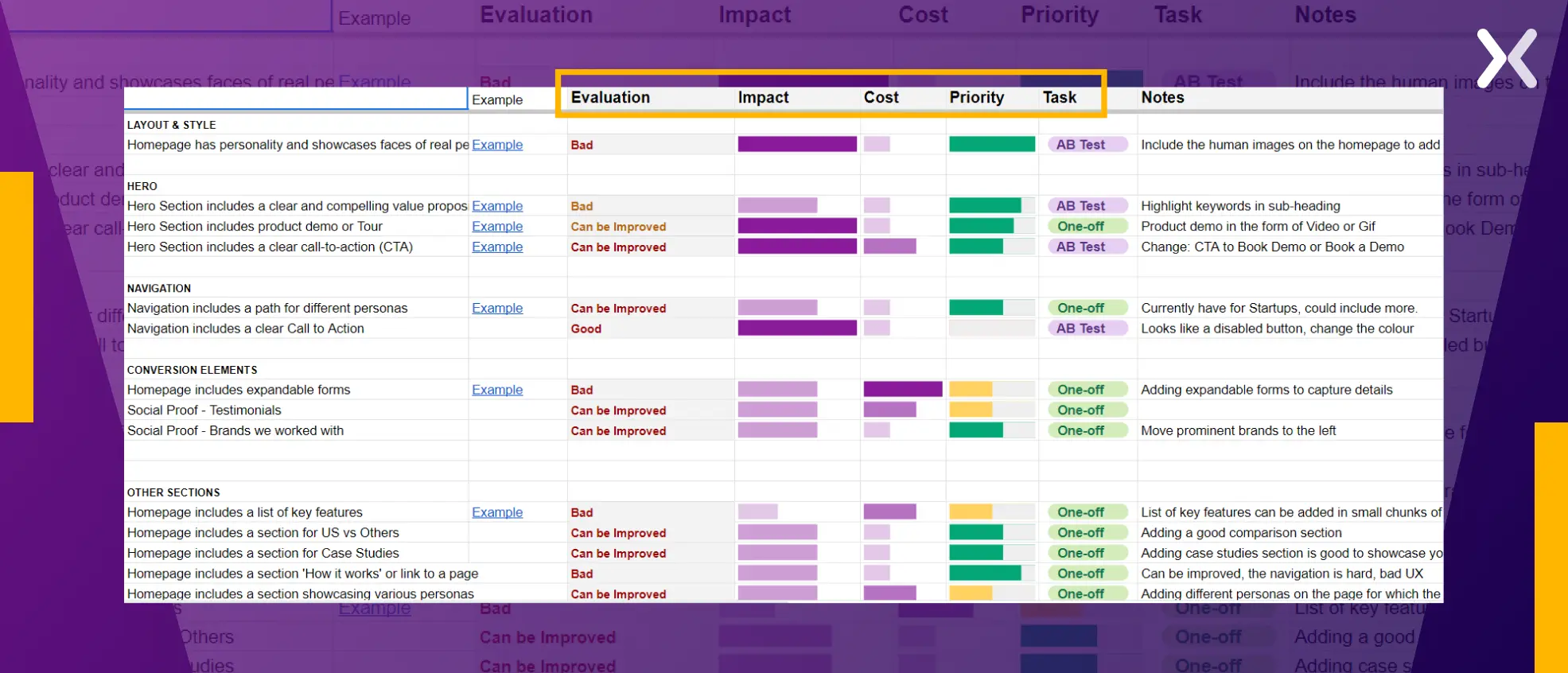
After setting everything up, establish an LPO (Landing Page Optimization) feedback loop to keep improving your optimization process and implementing landing page optimization best practices. Each test gives new insights, and every improvement shows key details about industry-specific elements that click with users.

Keeping these insights for future reference is essential. It builds a knowledge base that helps improve upcoming tests. When a test does well, the feedback should be used to make future testing more strategic and productive.
Let’s look at landing page optimization best practices in action with these case studies:
Flare, a scheduling software company, struggled with low conversions on its “Book a Demo” landing page.
Problem: After thoroughly analyzing their demo landing page, the Apexure team identified that the current landing page suffered from content overload and UX issues, particularly navigation challenges on mobile devices.
Solution: Apexure optimized the landing page by focusing on three key elements:
Headline: Making the page more intuitive.
Social proof: Making the page more persuasive.
Form: Making the page easily usable.

Result: By A/B testing different variations, we found a winning version that increased the landing page’s conversion rate by 65%.

IMD, a leading business school, aimed to increase brochure downloads for its MBA program. Apexure helped them build a landing page, making tracking and converting visitors easier. To further improve the conversion rate of IMD’s landing page, Apexure started building hypotheses and testing.
Hypothesis Building: One hypothesis focused on moving video social proof up the page to increase user engagement, and the other focused on driving the “About Us” section further up the page to build early trust.
Both hypotheses were merged and executed using the same landing page variation.
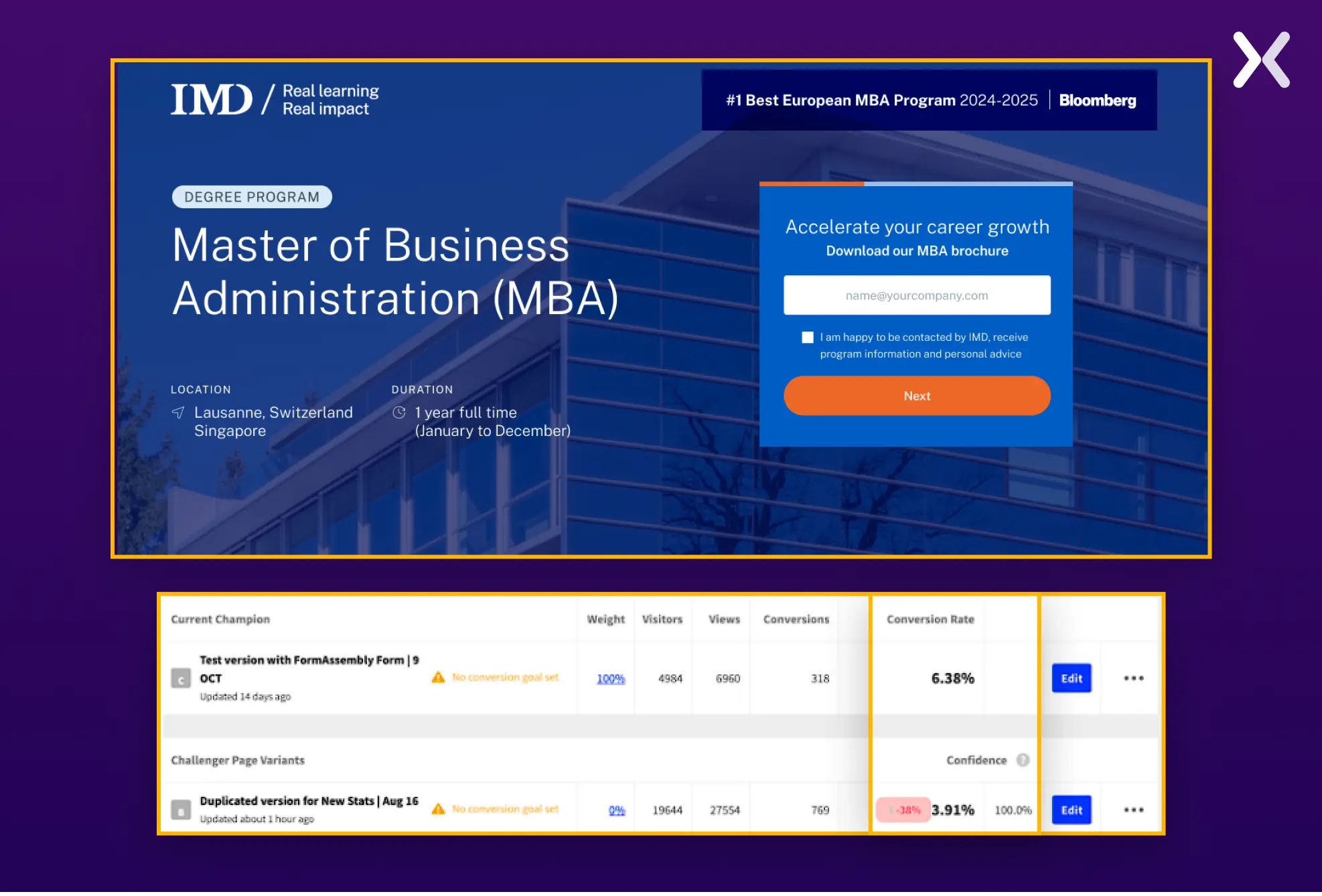
Result: Improved the conversion rate from 3.91% to 6.38%, resulting in a 63% increase in conversions.

It’s crucial to keep your landing page’s design simple. Below are landing page optimization examples and a checklist with all the elements divided into sections to implement landing page optimization best practices.
Your landing page must be practical and optimized to provide visitors with an uninterrupted and smooth user experience. Following landing page optimization best practices, clutter and unfriendly functions should be eliminated as a priority.
Here are the two primary elements you can work on for better functionality:
To enhance functionality, experiment with different layouts that maintain visual clarity and effectively use whitespace. It’s super important to have a page that’s easy to navigate, so the balance between whitespace and essential content is a big deal. See how different design layouts work to find the ultimate mix of whitespace, clickable elements, and pictures for a smooth user experience.
Check one of the landing page optimization examples that Apexure worked on. Notice the difference in the layout of before and after.
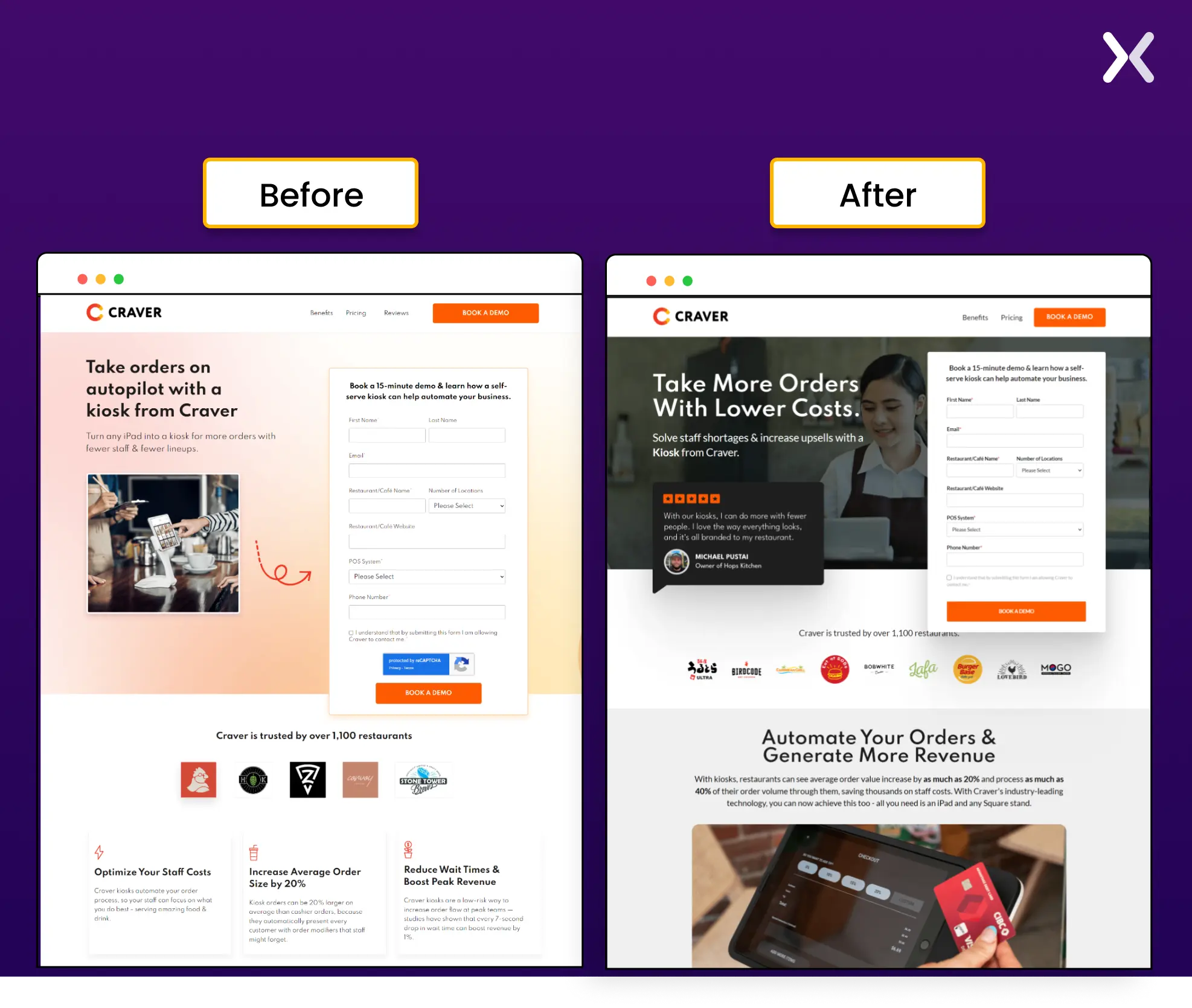
Session recordings capture user interactions on your page and are invaluable in identifying layout issues such as confusing navigation paths or missed elements. Tools like Crazy Egg and Hotjar offer session recordings to provide real-time insights into how visitors interact with your landing page.
Page speed matters for a functional landing page. A remarkable difference with all landing page optimization examples you will see is how fast the page loads after optimization. No one likes to wait forever for a page to load; they might just bounce if it’s too slow. Keep an eye on how fast your page loads, and do it often. Remember to check your page speed on phones and other devices so users across all platforms get a speedy and seamless experience.

Tools like Google PageSpeed Insights can help you identify areas to optimize and provide actionable insights to boost performance. A page that loads fast keeps users happy and pushes for higher conversions.
A huge part of maintaining a landing page’s functionality is continuously tracking its performance and testing it to improve conversions. Regular A/B testing and performance tracking protect your current conversion rate and align with best practices for optimizing landing pages.
Such a proactive approach protects your conversion rate and helps to increase it gradually. Tools like Google Analytics can give you insights into user behavior to optimize elements based on data, improving your page’s effectiveness and engagement.
Accessibility is a critical factor in ensuring good landing page optimization. This requires creating a landing page that impacts your visitors no matter what device they access it from.
Ensuring accessibility means designing for responsiveness so your landing page works seamlessly on any device. Visitors may access your page from various screens—desktop, tablet, or smartphone—especially if it’s a landing page for social media ads, where mobile access is high.
It requires not only optimized page speed but also a smooth, tailored experience across devices. Testing options include trying a more minimal layout for mobile, implementing hamburger menus to save space, and optimizing CTA buttons so users can easily tap them with a thumb or index finger.
Below is one of Apexure’s landing page optimization examples, where we optimized the desktop and mobile versions, both.
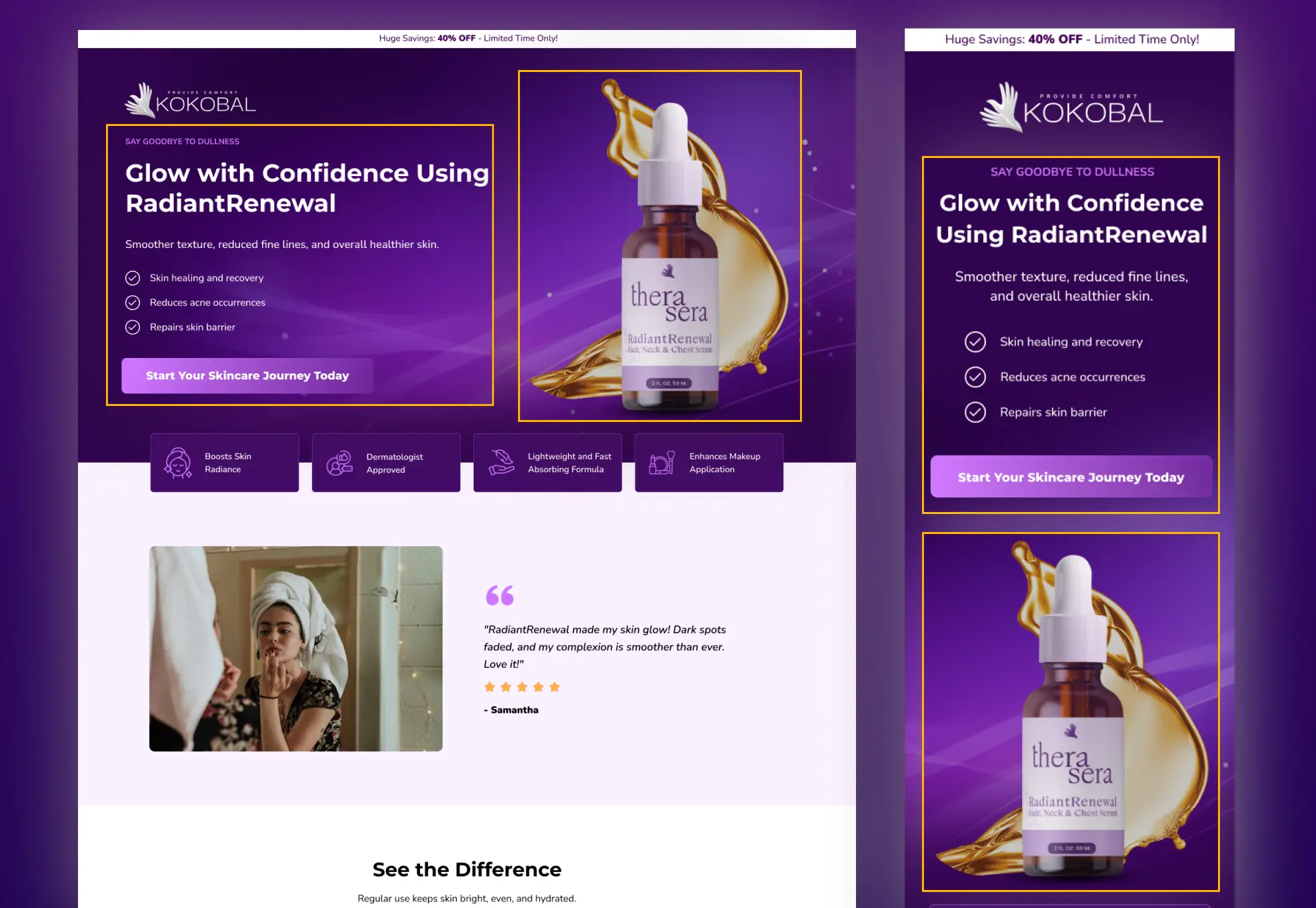
For mobile, also experiment with shorter, straightforward copy and test headlines and subheads to capture user attention while communicating the value of your product.

“Mobile optimization is often neglected. Mobile users need tailored experiences with larger buttons, readable text, and device-specific designs—especially for older demographics.”
Testing click-to-call buttons can provide a direct way for visitors to connect without filling out forms.
Ensure your contact information—phone number and email—is visible on the page. Click-to-call buttons are best suited for bottom-of-the-funnel landing pages, such as those for product landing pages, sales landing pages, or payment landing pages, as they encourage qualified leads to take action.
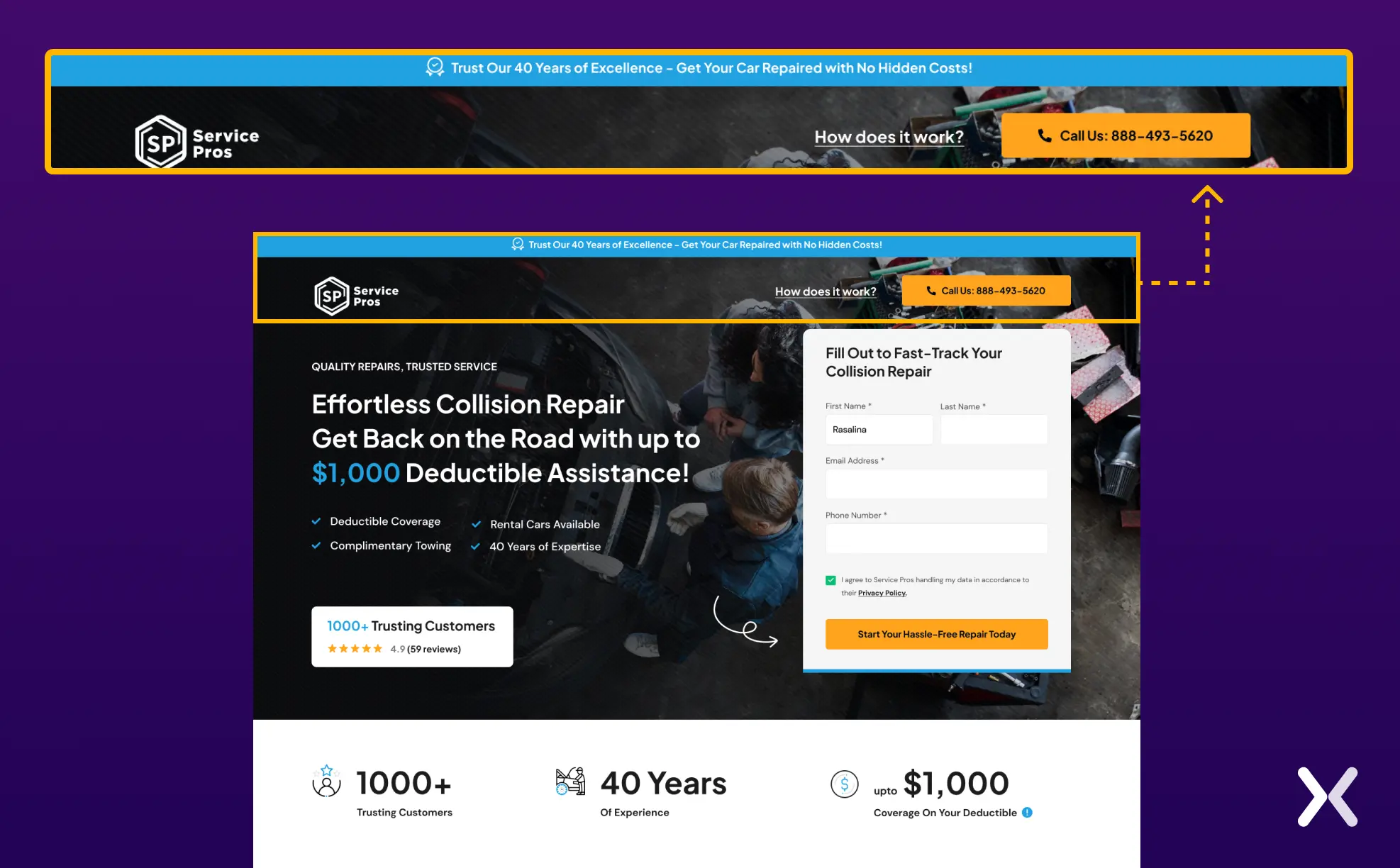
Don’t use click-to-call buttons on other landing pages to avoid calls from unqualified prospects. Experimenting with click-to-call can improve conversions by making it easier for users to reach out when they’re ready to buy.
Your next move should be to ensure your landing page is not a maze. Stick to the best tips for making landing pages better—keep the page straightforward to walk through and cut out all the junk that’s not needed. Make your landing page work for the visiting target audience.
High drop-off rates on your form signal that it needs to be optimized. Kick-off by reducing it to just the essential form fields. Stick to the must-have info, and you’ll make filling the form smoother and increase the chances of folks getting through. If a long-form is necessary, a single form just won’t cut it. Test using a multistep form that helps break the long form into smaller, more digestible bits.
The landing page optimization examples below have both simple and multistep forms.
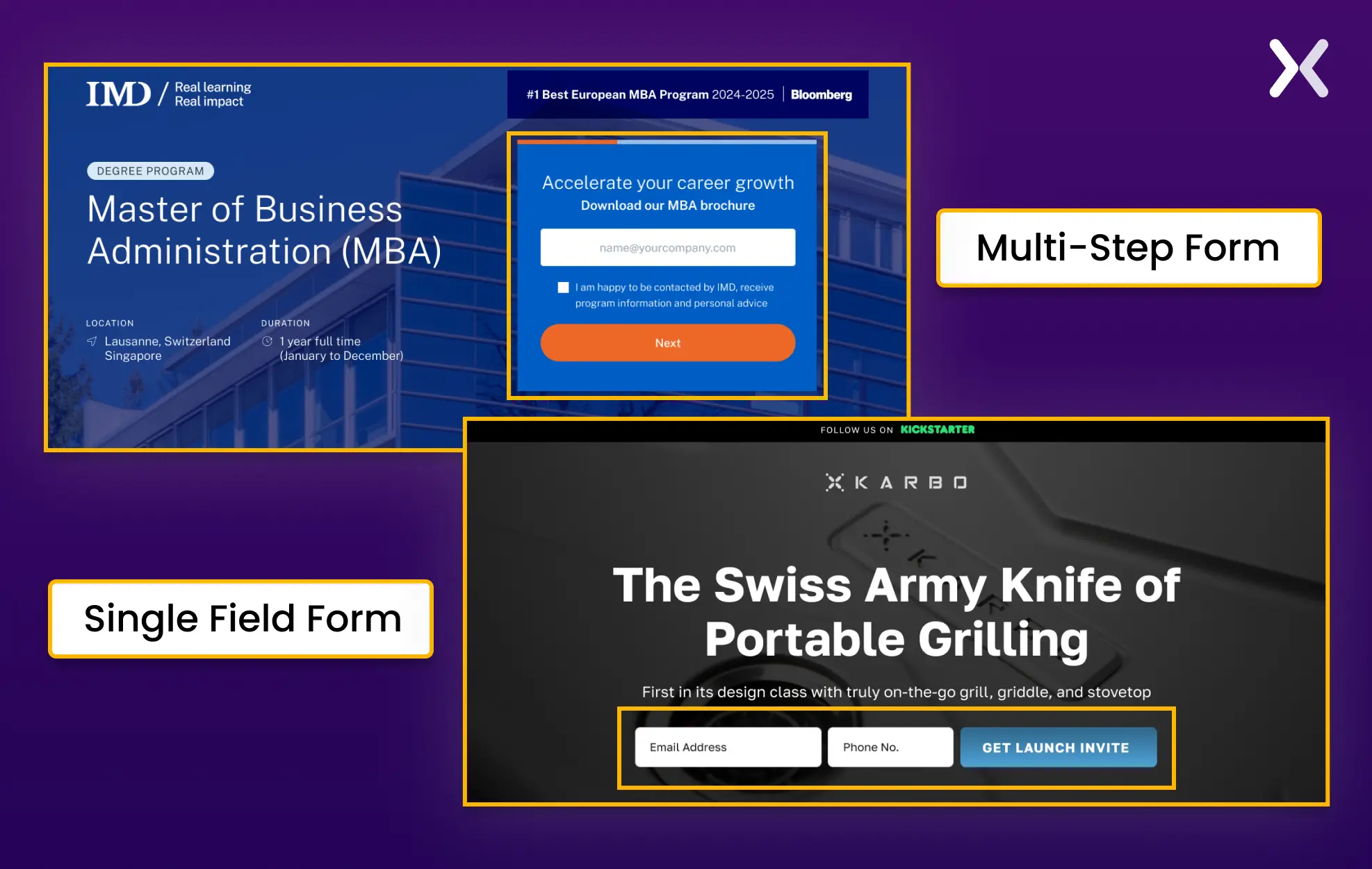
Try both single and multistep forms; you can see which style gets more visitors to finish the form, boosting your landing page’s ease of use.
When dealing with a long landing page with essential information, low scroll depth may signal that users are disengaging before reaching key sections. In such cases, testing a sticky navigation bar can enhance usability.
Landing page optimization examples with a sticky navigation bar must cue that the page is long.

This type of nav bar remains visible while users scroll, letting them jump to parts that catch their attention without endlessly swiping up and down. It’s useful for visitors looking for specific information about your offering. It allows users to explore your page more efficiently, improving user experience.
While this fourth step seems vague, it is one of the most crucial elements of landing page optimization best practices. The point is always to ensure your visitor instantly understands your essence and brand.
Say your landing page has a high average time on the page, but users are not hitting the CTA button often. That’s your cue to look closer at your main message and where you’re telling your visitors to act, as there is no need to change all your copy. Your main message concerns the big win people get when choosing your offering.
Start by using a heatmap tool. It’ll show where visitors click mostly on your page (the popular sections are highlighted in red). It helps ensure that users quickly grasp the primary benefits and actions available, improving the chances of conversion by aligning with visitor attention.
Your headline is typically the first thing visitors see, especially at the top of the page, so it plays a crucial role in reducing bounce rates. Test different headline copies to see what resonates if your page has a high bounce rate. The headline doesn’t need to be flashy; it should, first and foremost, reassure visitors they’re in the right place.
When you’re scanning through landing page optimization examples it is essential that you thoroughly analyze their top fold.
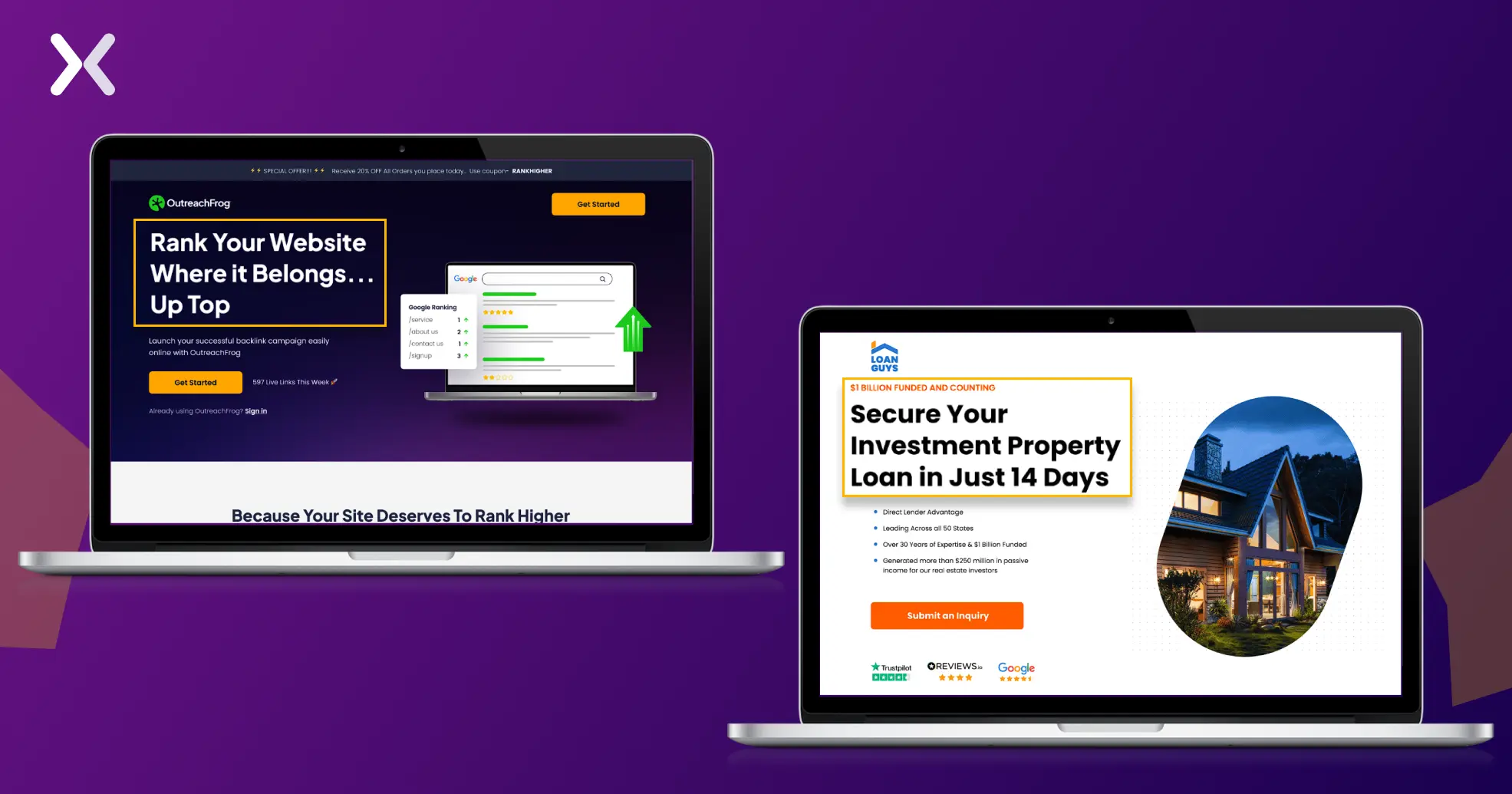
It’s essential that the headline, subheads, and any introductory copy align with the ad or link they clicked on, reinforcing continuity and clarity. Having aligned, straightforward messaging in the first fold can set clear expectations and encourage users to explore further.
Images and videos can be powerful tools for engaging users, but testing which type works best for your page is essential. Videos, for example, can boost engagement by efficiently delivering information, but they don’t work for every landing page.

Especially if you have a SaaS tool, test if including a video enhances user experience. For images, especially the hero shot in the top fold, select visuals highlighting your product’s unique appeal or features. Testing different visuals allows you to find the best combination that captures visitor attention and effectively communicates the value of your product or service.
A landing page must motivate visitors to take action by showcasing clear value, building trust, and creating urgency. Persuasiveness uses social proof and limited offers to close the gap between visitors’ interest and commitment. So, while functionality and usability act as the pillars for a landing page success, persuasiveness ensures users follow through.
Here are elements to optimize if you want to increase persuasiveness on your landing page:
Trust signals play a vital role in reinforcing the credibility of your claims and encouraging visitors to engage with your product or service. They act as social proof, backing up your promises and helping visitors feel confident in their choices.
In most of the landing page optimization examples, you will see that the page has more social proof than before.
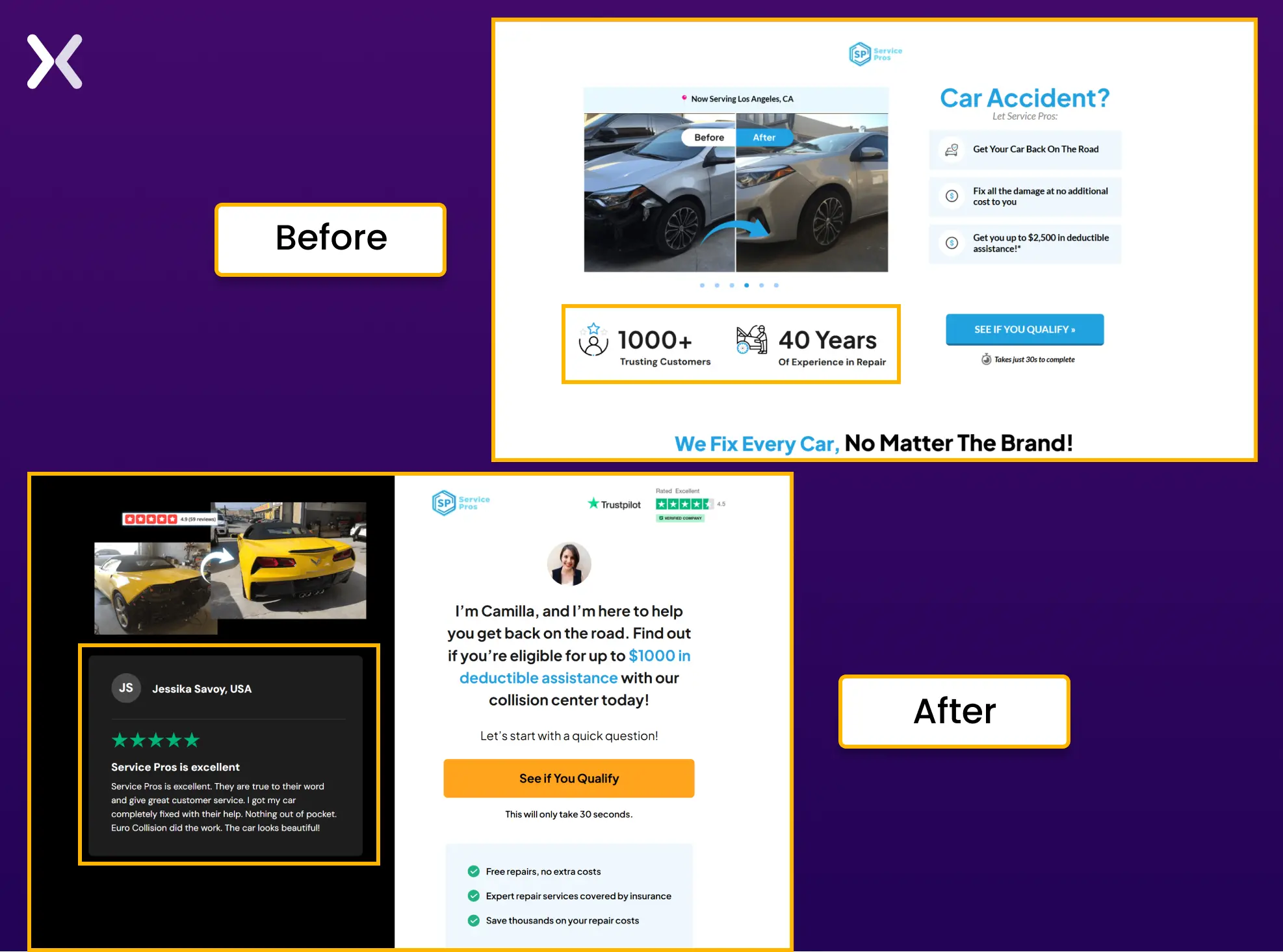
To maximize their effectiveness, experiment with placing trust signals—such as testimonials, client logos, or certifications—in key areas across the landing page. If a dedicated social proof section isn’t yielding results, try positioning these signals near your call-to-action or product highlights to increase visibility and impact.
Creating urgency on a landing page can prompt visitors to act more quickly, suggesting limited time or availability. For event landing pages, showcase exclusive discounts for limited seats and use countdown timers to remind visitors of upcoming deadlines.
For other offers, limited-time discounts work well; you could also experiment with phrases like “today only.” Urgency can also be conveyed in the page’s copy itself. For instance, a message like “Get 25% off—only till Christmas!” can subtly encourage faster decisions, increasing the likelihood of conversion by prompting visitors to take immediate action.
Following landing page optimization best practices can help you grow your conversion rate further. Instead of waiting for a metric to drop, landing page optimization requires proactive planning and implementation, so you’re always two steps ahead of your competitors.
Our landing page optimization checklist will help you optimize your landing page according to its lagging area, whether functionality or usability. Whether you’re planning on building a landing page or already have one, landing page optimization best practices can always guide you to aim for higher growth and ROI.
Did you know that Apexure has 100+ blog posts on landing pages optimization. From creation to testing, analysis to optimization, we have shared everything. Check it out before your building your landing page.
Landing page optimization on your own can be overwhelming. Get the help you need with our experts. Book a call and one of our landing page experts will contact you soon.
Check out our landing page portfolio to discover conversion-friendly landing page elements that might be missing from your campaigns. Filter your industry and check which landing page design is trending.
Use A/B testing, ensure mobile responsiveness, optimize headlines and visuals, and match the design to the source ad or campaign.
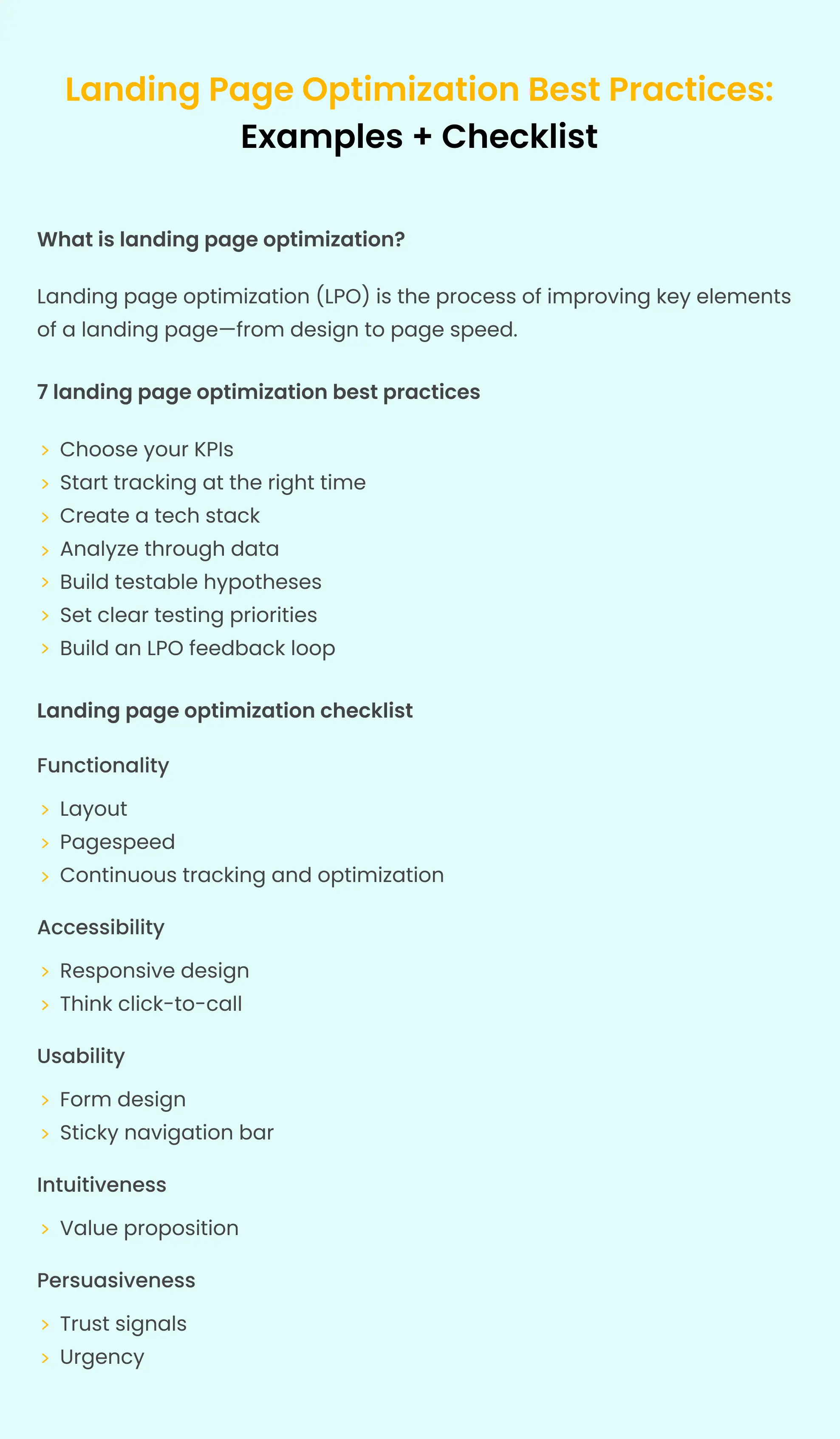
Related Articles:
Drive More Sales or Leads With Conversion Focused Websites and Landing Pages
Get Started.png)
In today’s fast-paced digital world, having a responsive website is no longer just a nice-to-have, it’s essential. Whether...
As artificial intelligence continues to evolve, businesses are finding innovative ways to enhance their marketing efforts. One of...
Get quality posts covering insights into Conversion Rate Optimisation, Landing Pages and great design